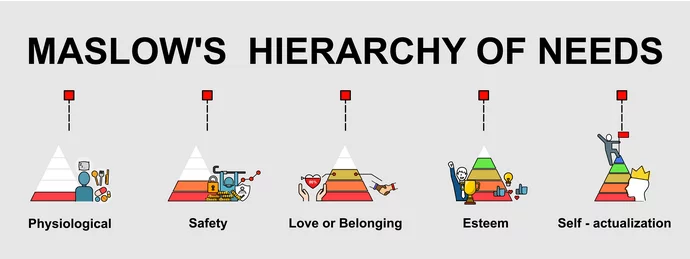It is important to regularly engage with employees. Most people now work from home due to the Covid-19 restrictions, this can you feel isolated and reduce your levels of motivation.
Maslow’s Hierarchy of Needs can help business owners keep employee engagement levels high. This theory was designed by the psychologist, Abraham Maslow, and it suggests that humans are motivated to satisfy five important needs, which are arranged in a hierarchy.
What is Maslow’s Hierarchy of Needs Theory?
In psychology, this is a motivational theory. Also called Maslow’s theory of motivation, the hierarchy is often shown as a pyramid to represent the need to fulfill the lower levels before a person can move up to the next level. It is impossible to progress to the next level without first fulfilling the current level because you’ll not have the motivation to do so.
According to Maslow, we first seek to satisfy the lowest level of needs. After doing this, we desire to satisfy the other higher levels of need until all levels have been satisfied. The levels of needs allow a person to feel fulfilled. Most organizations apply them in the workstations as a means of determining how to effectively motivate employees and ensure that their needs are met.
Knowing how to apply this hierarchy can help companies determine if their business goals are met or not, and how they can better meet the needs of their teams.
Applying Maslow’s Hierarchy of Needs in the Workplace
-
Physiological needs
Maslow realized that individuals have to deal with the survival needs before they move on to any other level of needs. Without the necessary water, food, clothing, and shelter needed for survival, they’ll not be concerned about acquiring new skills to qualify them for future tasks. In the workplace, basic things such as coffee, clean water, and snacks will go a long way in meeting the basic physiological needs of employees.
In this hierarchy, physiological needs are the most basic human needs. Employees should be able to access important services and opportunities in the workplace to feel that their most basic needs are met.
They need a comfortable working environment, breaks to eat, access to a restroom, and a place to get drinking water. One of the most important physiological needs in the workplace is also a steady income to pay for food, clothing, a place to live, and other utilities.
-
Safety needs
Another important need is safety. It can influence your general satisfaction with your workplace.
Worrying about your safety and that of your loved ones is natural. For instance, one of your priorities could be to provide a safe living environment for your loved ones, which is why you work hard to achieve that. At your workplace, it’s also vital to feel that your physical safety is prioritized. Your personal belongings should be safe and protected.
Ensuring safety in the workplace may include providing ergonomic office furniture that reduces the risk of injury, and securing the building to prevent external threats. Also, safety in the workplace could mean feeling emotionally safe and supported. You shouldn’t constantly worry about losing your job due to layoffs or budget cuts. If you feel unsafe, you’ll find it difficult to be motivated to advance to the next level in the hierarchy and perform at your highest level.
-
Social needs
This level in Maslow’s hierarchy of needs in the workplace deals with acceptance, friendship, love, and companionship. As a business owner, you can address the need that most employees have to socialize and feel as if they’re part of a group by creating a work environment that creates opportunities for participation and interaction with other employees.
You can start networking sessions before or after office hours. Happy hour can be a good time to network and have fun – and it doesn’t need to be at a pub. Also, celebrating anniversaries and birthdays will allow your employees to interact and build relationships in the workplace.
-
Esteem needs
At this level of Maslow’s hierarchy, the focus is placed on personal ego; achievement, self-respect, and receiving recognition for work done. Workers want to be appreciated and respected by their coworkers and their employers. In a learning work environment, you can address this need by recognizing accomplishments, focusing on the expertise of a person, and applauding accomplishments.
Also, during training, you can have and present accolades in which participants cheer the efforts of deserving recipients. A simple round of applause might be appropriate to meet this basic need. Employee awards will also create a goal-oriented workplace.
-
Self-actualization
This stands at the peak of the hierarchy. Self-actualization plans, training, and mentoring for employees enable them to be the very best they can be.
Your company can achieve the self-actualization needs of employees by organizing regular talent planning meetings among HR and managers, having career discussions with workers, and providing options like fast-track management programs.
Doing this will give employees opportunities to succeed and provide them with the expertise to meet future vacancies. Bosses should focus on the skills and abilities of employees; help them look for ways to advance their careers without pushing them into unfitting roles.
(Also Read: How to Increase Workplace Diversity)
How to Apply Maslow’s Theory in the Workplace
According to Maslow’s theory, an employee begins by focusing on the lower order needs of physiology and security. A person that has just begun their career will be more concerned with physiological needs like stable income and security needs. Once these basic needs are met, the employee will now focus on social needs.
With these needs met, a worker will want to meet higher-level needs such as self-esteem needs. These needs are tied to the image of an employee and his desire for the respect and recognition of other coworkers. Even if the employee doesn’t desire to go into management, he likely doesn’t want to keep on doing the same task for 10 years.
To make work more rewarding, carry out cross-training, job enrichment, and special assignments. Additionally, allow workers to get involved in decision-making. Managers should provide rewards to employees. Rewards need to be balanced to have the best effect.
Final Thoughts
This basic motivational tool is still important today, and as such, it can help business owners achieve their organizational goals, such as higher staff retention and more employee engagement. But they have to know how to apply it practically and constantly adapt to meet the changing needs of their employees. However, keep in mind that what motivates one employee may not necessarily motivate another.






